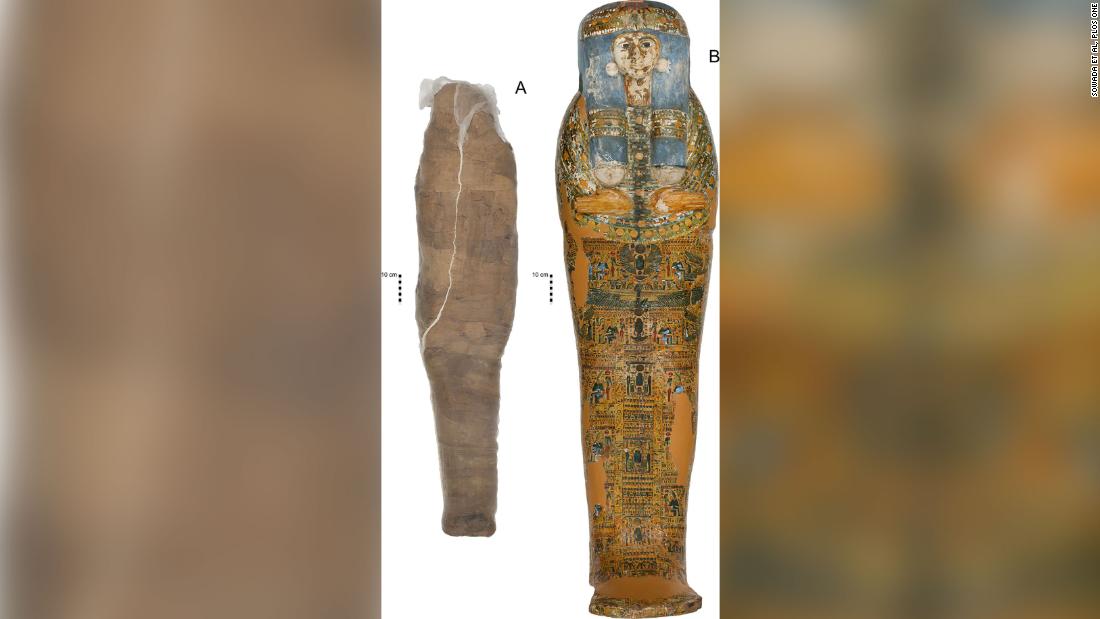The mummy was a socially esteemed woman named Meruah, according to the inscription on the coffin dating from around 1000 BC. Another group of researchers discovered the age of the coffin in 1988.
The new technology allowed researchers to perform virtual dissections and, therefore, better characterize the carapace layers around the body in 2017. That’s when the The University of Sydney was preparing to open its Chau Chak Wing Museum, “which has a dedicated space for ancient Egyptian material from the Nicholson Collection,” said Sowada, a researcher in the history and archeology department at Sydney’s main campus at Macquarie University, via email.
The shell layers were made of minerals, which differed from the expensive resin used for elite mummified individuals. “This is the first time that a painted mud shell treatment has been discovered,” added Sowada.
“Many coffins had their original occupants stolen in ancient times. It is likely that in the local antiques trade in the 19th and early 20th centuries, many coffins for sale were empty,” said Sowada by email. “Traffickers obtained complete mummified bodies found in desert cemeteries and placed them in coffins to sell complete ‘sets’ to tourists, even if bodies and coffins did not belong to each other.
“It was fashionable for foreign tourists to come home with an Egyptian mummy.”
The body’s internal reproductive organs were removed during the mummification process, and the genitals were not seen in the images, so more detailed analysis of DNA samples is needed, said Sowada. “However, this would require additional invasive involvement through destructive testing, and this needs to be considered carefully at several levels.”
The change in sex determinations for a mummy “happens all the time,” said Peter Lacovara, director of the Ancient Egypt Archeology and Heritage Fund and a consultant curator for the Egyptian Collection at the Albany Institute of History and Art in New York State . “At the Albany Institute, we had a mummy that had previously been identified as a woman, and we took her to be tested and found out that it was a man.”
“Sometimes it is more difficult to say with old bodies; there seems to be less distinction, or we perceive it less clearly.”
The DNA collected at that time may be contaminated, the authors said.
The body also suffered damage shortly after the initial mummification, including the separation and displacement of the skull, jaw and parts of the spine. Some bones were far from their correct place – the left kneecap was at the level of the left ankle and the right kneecap was below the bone of the left thigh. Some bones were fractured.
“Mummification dehydrates and stabilizes body tissues, so we would expect to see very little (if any!) Post-deposition movement or disarticulation of any bones,” said Sowada by email.
“CT scans of that person’s body show us that they have been subjected to significant disturbances – but also, more importantly, that they have received a lot of care to restore them after being disturbed.”
The body was then rewrapped, packed and padded with fabrics, in addition to the application of the mud shell. The mud shell “probably served a triple purpose,” said the study. It was a form of conservation for a body that had suffered significant damage, for example, and may have served a symbolic purpose as well.
“The carapace helped the metaphysical transition from the deceased to the afterlife and the sphere of the god Osiris,” said the study. “The mythological experiences of this underworld deity – his death, dismemberment, restoration and rebirth – were long established to serve as a precedent for the mortuary experience of all Egyptians. … Like the god, the deceased could also hope for existence continued into the afterlife, when properly prepared. ”
“The mud itself was associated with the idea of regeneration and growth,” said Sowada, “so it would be a symbolically significant material to use.”
Finally, since the minerals that make up the mud bark were cheaper options than the resin used for elite mummified individuals, they may have allowed repairmen to display status by emulating mummification practices for elite people.
The red pigment used on the part of the shell that covered the face was somewhat unusual for mummified women at that time.
“This practice is related to the belief that women assumed a temporary, crucial and after-death male aspect in death, so that they could be re-conceived and reborn in the afterlife through their own images (in the same way as they believed that male tomb owners would go through this process through representations of their female relatives or goddesses), “said Heather McCarthy, Egyptologist and deputy director of the New York University Epigraphic Expedition to the Ramses II Temple in Abydos, for and -mail. “The use of masculine, red and reddish brown skin tones is a pictorial signifier of this fluid state of gender.”
The findings help to build a larger and more subtle picture of how the ancient Egyptians treated and prepared their dead, Sowada said.
“It is likely that previous studies of mummified bodies in other collections, where a ‘resin’ shell has been identified, will need to be re-examined for the possibility that the shell is made of mud,” she added. “The application of scientific techniques to museum collections reveals the wealth of new information right under our noses.”
